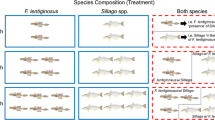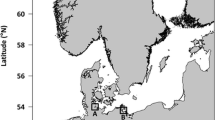Abstract
Most studies on feeding by herring larvae (Clupea harengus) have taken place in clear, open waters, but several herring stocks around the world spawn in inshore and estuarine regions. An example is the spring-spawning Blackwater Estuary (Essex, England) stock. Samples were collected in this estuary to examine prey selectivity and feeding levels in relation to biological and environmental conditions. Herring larvae negatively selected copepod nauplii, but positively selected the copepodite and adult stages of Acartia spp. Gastropod larvae were also positively selected. Particles >150 μm width were preferred, whilst particles smaller than this value were preferentially rejected. Concentrations of potential prey items in the water were in the range of 6.0 to 49.7 organisms l−1 with a median concentration of 15.0 organisms l−1 (n = 26). These values are towards the low end of prey concentrations quoted in the literature as being required to sustain herring larval growth and survival. However, theoretical considerations suggest that, in this environment, levels of tidally-induced turbulence enhance encounter rates between larval herring and their prey. On the other hand, turbidity is also related to tidal current speed and might reduce feeding success by decreasing underwater light levels. Measurements at two sites in the estuary confirmed that tidally-induced turbidity reduced the effective water depth in which herring larvae could visually feed by up to 50% at times of peak current speed. However, with the gut-content data available in the present study, it was not possible to discern any clear relationships between feeding success and the state of the tide. Feeding success appeared to be more strongly influenced by surface light-levels.
Similar content being viewed by others
Author information
Authors and Affiliations
Additional information
Received: 24 June 1998 / Accepted: 17 February 1999
Rights and permissions
About this article
Cite this article
Fox, C., Harrop, R. & Wimpenny, A. Feeding ecology of herring (Clupea harengus) larvae in the turbid Blackwater Estuary. Marine Biology 134, 353–365 (1999). https://doi.org/10.1007/s002270050552
Issue Date:
DOI: https://doi.org/10.1007/s002270050552




